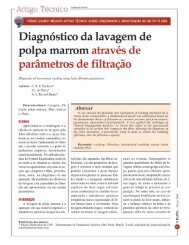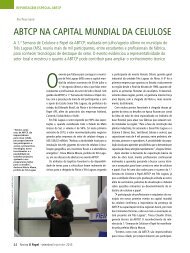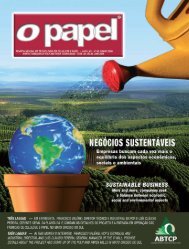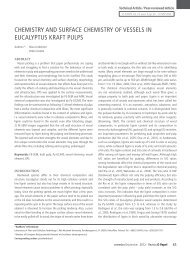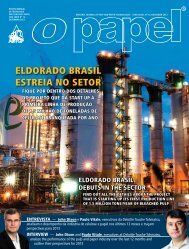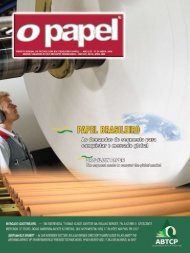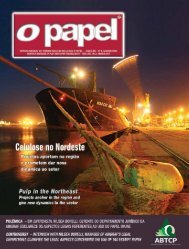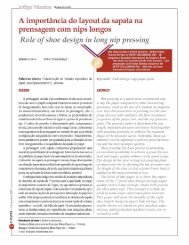You also want an ePaper? Increase the reach of your titles
YUMPU automatically turns print PDFs into web optimized ePapers that Google loves.
Technical Article / Peer-reviewed Article<br />
O PAPEL vol. 73, num. 7, pp. 57 - 65 JUL 2012<br />
swelling measured as WRV. In our study, no effect on the apparent<br />
yield stress due to differences in WRV was observed, but during<br />
refining an increase in WRV involves a swelling of the whole fibre<br />
and is not specifically due to the fibre surface effects.<br />
The interpretation of these results is that there are no major<br />
differences in rheological behaviour among fibres in different<br />
ionic forms measured with a plate rheometer, and that differences<br />
in rheology may not be the major factor explaining the improved<br />
refinability of fibres in the Na + -form. It would however be very<br />
interesting and informative to study the relation between gap<br />
clearance and refining power for fibre suspensions in different ionic<br />
forms in a single-stage refiner. A different power gap clearance<br />
relationship for fibres refined in different ionic forms would indicate<br />
differences in rheological properties of the fibre suspension under<br />
realistic refining conditions. The relationship between refining power<br />
and gap clearance is a valuable tool for understanding the refining<br />
behaviour (Mohlin, 2007; Koskenhely, 2007; Bäckström et al., 2009b).<br />
Fibrillation<br />
The results showed that data regarding the degree of fibrillation<br />
can vary a lot depending on the techniques used, and this should be<br />
borne in mind when interpreting the data. The fibrillation levels for<br />
the pulps obtained by the image analysis methods correspond well<br />
with what has been reported by Wang (2006) and Kang (2007) using<br />
the same technique. Also, the values for the MMS light scattering<br />
method are representative for refined pulps and the method will<br />
be developed as an on-line method (Pettersson, 2010). The results<br />
showed that the type and characteristics of the fibrils on the fibre<br />
surfaces were different, depending on the ionic form. The fibres in the<br />
Na + -form were more fibrillated, but had tiny and rather short fibrils,<br />
whereas fibres in the H + - and Ca 2+ -forms had coarser and longer<br />
fibrils as seen in the microscope, Figure 8-10. These differences could<br />
not be detected with the image analysis method, but the MMS light<br />
scattering method detected both types of fibrillation and showed<br />
that the Na + -fibres had more fibrils, measured as surface area, than<br />
fibres in the H + -form (Table 2).<br />
Our results indicate that the refinability of fibres in different ionic<br />
forms is related more to the fibre and fibre wall than to the rheology<br />
of the fibre suspension. Changing the ionic form of fibres changes the<br />
swelling behaviour, but also the pores within the fibre wall (Salmén<br />
and Berthold, 1997). Forström (2004) has shown that the radii of<br />
pores inside the fibre wall is larger in fibres in the Na + -form than<br />
those in the H + -form. It is not possible, on the basis of our results, to<br />
relate the improved refinability of fibres in the Na + -form to changes<br />
in the pore structure of the fibre wall, but the fibres refined in the<br />
Na + -form give a different fibrillation pattern, and this difference is<br />
probably due to differences within the fibre wall.<br />
Fibres in the wet state always contain water to some degree,<br />
and additional water can be taken up (swelling) if chemical<br />
groups attached to the macromolecular network of the cell wall<br />
are ionized. To maintain electrical neutrality, the counterions<br />
to these groups must be maintained in the wall. This creates<br />
a concentration of mobile ions within the wall that is greater<br />
than that in the liquor outside the wall, and thus a difference<br />
in osmotic pressure arises. Extra water is drawn into the wall<br />
to reduce this difference. However, an increasing resistance to<br />
expansion of the cell wall is provided by the elastic nature of the<br />
wall. Eventually, the osmotic pressure equals the elastic tension in<br />
the wall matrix. Gellerstedt and al. (2000) showed that swelling<br />
- by introducing additional charges onto the fibres with succinic<br />
acid - increased the osmotic pressure above the cell wall elasticity<br />
and delaminated the cell wall.<br />
Our results can be interpreted as indicating that the reason for<br />
the improved refinability of fibres in the Na + -form is mainly due to<br />
co-operation between the increased osmotic pressure in the fibre<br />
wall and the mechanical stress. The hypotheses is: as mechanical<br />
forces are applied to the fibre and the fibre wall, the electrostatic<br />
repulsion due to the ionization provides an additional aid to<br />
increase the swelling, and this helps to delaminate the fibre wall.<br />
This improves the refinability in terms of an increase in WRV for a<br />
given energy input, but also leads to a different fibrillation pattern<br />
where smaller fibrils are obtained when the fibres are in their Na + -<br />
form. When refining of fibres in the H + -form, a large proportion of<br />
the charged groups in the fibres are undissociated, which largely<br />
means that mechanical energy is transferred to the fibres without<br />
any electrostatic interaction. This is not totally true, because at a pH<br />
level of 5 some groups are dissociated (Laine, 1994). On the other<br />
hand the Donnan equilibrium calculations made by e.g. Grignon and<br />
Scallan (1980) show that the pH is much lower within the fibre wall<br />
than in the surrounding medium, especially at low ionic strength.<br />
When the fibres are transferred into the Na + -form, the charged<br />
groups in the matrix are ionized and, as the mechanical energy<br />
is transferred by the refiner, the electrostatic nature of the matrix<br />
co-operates to delaminate the fibres, the so called “electrostatic<br />
repulsion assisted refining” described by Bäckström and Hammar<br />
(2010) and in harmony with the interpretation of Laivins and Scallan<br />
(2000) that chemical and mechanical processes are additive under<br />
alkaline conditions.<br />
CONCLUSIONS<br />
The results show that the rheological properties, measured with a<br />
parallel plate rheometer, may not explain the improved refinability<br />
of fibres refined in the Na + -form, since fibres in different ionic forms<br />
showed similar rheological properties.<br />
Fibres refined in the Na + -form showed, according to measurement<br />
using the MMS system and microscopic investigation, a larger<br />
amount of external fibrillation and different fibrils characteristics<br />
than fibres refined in the H + - and Ca 2+ -forms. The observed differences<br />
in fibrillation and refinability may be interpreted as being due to a<br />
co-operation between electrostatic interactions within the fibre wall<br />
as a result of ionization of the charged groups and the mechanical<br />
forces applied during refining.<br />
julho/July 2012 - <strong>Revista</strong> O <strong>Papel</strong><br />
63



